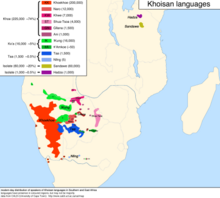Sandawe language
Sandawe's use of click consonants, a rare feature shared with only two other languages of East Africa – Hadza and Dahalo, had been the basis of its classification as a member of the defunct Khoisan family of Southern Africa since Albert Drexel in the 1920s.
Recent investigations however (Güldemann 2010) suggest that Sandawe may be related to the Khoe family regardless of the validity of Khoisan as a whole.
They have so far produced a phonological description, a dialect survey report and several papers on aspects of grammar.
Wright et al. transcribe this slapped click or sublingual percussive with the extended-IPA symbol ⟨ǃ¡⟩.
The voiced clicks are uncommon, being found in a few words such as gqokomi 'greater kudu' and gcingco (sp.
In initial position, the glottis is closed during the entire occlusion of the click, and not opened until after the release burst.
In Sandawe orthography, they are written as exactly with their IPA spelling, but the rising tone is marked as ǎ.
[clarification needed] This analysis requires the assumption of floating low tones carried by consonant clusters, and thought to reflect a historical vowel which has been deleted.
Glottal stops /ʔ/ are found as syllable codas, though these may be released in an echo vowel in some circumstances.
Historically, these are presumably due to vowel elision, as evidenced by records from the early 20th century and also by tone patterns.
In the northwestern dialect, words are found with final consonants where tonal patterns suggest there was once a voiceless final vowel, and where the southeastern dialect retains a voiceless i or u. Sandawe syllables are usually of the form CV; in monosyllabic words, word-final nasals are not uncommon, CV(N).
However, word order in the Sandawe sentence is very flexible due to the presence of several 'subject identification strategies'.
Sample sentence (mid tones are not marked): úte-syesterday-Ikxʼaré-ésboy-Ihàʔǃàcalledúte-s kxʼaré-és hàʔǃàyesterday-I boy-I called'Yesterday I called a boy.
'[3]An article in Studies in African Linguistics, Volume 10, Number 3, 1979, by Gerard Dalgish, describes these 'subject identification strategies' in detail.
The most promising candidate as a relative of Sandawe are the Khoe languages of Botswana and Namibia.
However, other linguists have criticized the proposal as cherry-picking among a large number of non-matching pronominal forms.
For example, the Sandawe word for 'horn', tlana, may be a cognate with the root nǁâ found throughout the Khoe family.

